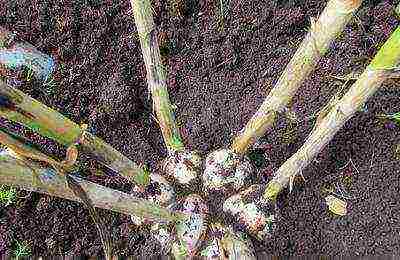Content [show]
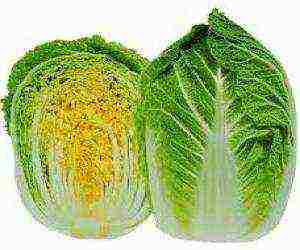 Peking cabbage is a cold-resistant, annual vegetable crop. The growing season does not exceed 2 months, from sowing seeds to the formation of a full-fledged head of cabbage.
Peking cabbage is a cold-resistant, annual vegetable crop. The growing season does not exceed 2 months, from sowing seeds to the formation of a full-fledged head of cabbage.
Upon reaching commercial qualities, depending on the variety, it can have a cylindrical, short-oval, long-oval, dense or loose head of cabbage. The average leaf length is 25 cm, the structure and color of the leaf plates can also vary significantly - the color range is from deep green to light green, the structure is slightly swollen and wrinkled.
Peking cabbage is grown in all types of protected and open ground as a compactor for tomatoes, zucchini, cucumbers, cabbage, or as an independent crop.
How to grow Chinese cabbage correctly?
Experienced gardeners and beginners are often tormented by questions related to the cultivation of new, unusual crops, and Chinese cabbage, in this regard, is no exception. Here are just a few of them:
- How to grow Chinese cabbage outdoors?
- Can plants be fed during the growing season?
- Which seedlings or seeds are preferred?
- How and when to water?
Despite the seeming unpretentiousness, the cultivation of Peking cabbage has its own nuances and small tricks, non-observance of which can significantly reduce the yield and nullify all the efforts made by the gardeners.
Seedlings or seeds?
By what method, seedlings or seeds, to plant Peking cabbage depends on individual conditions, i.e., where and how the plant will develop: in a greenhouse, on ridges, in open ground, what is the average length of the day, planting time (spring, late summer) ...
Important! When planting and cultivating Peking cabbage in hot and / or dry times, the plant sharply turns into color and heads of cabbage are not formed. In addition, the culture begins to actively release arrows even under excessive illumination, including during the long white nights, which are typical for some northern regions, as well as Siberia.
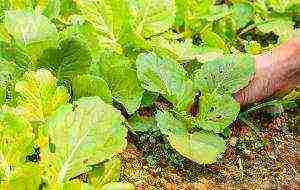 The cultivation of Peking cabbage in Siberia and the Urals is quite possible, but it is necessary to artificially adjust the illumination, i.e. choose areas with shade or forcibly cover plantings from light in the greenhouse.
The cultivation of Peking cabbage in Siberia and the Urals is quite possible, but it is necessary to artificially adjust the illumination, i.e. choose areas with shade or forcibly cover plantings from light in the greenhouse.
- Greenhouse:
- seeds - sowing is carried out in March, early April, late July, as well as in the first decade of August. Sowing pattern 20 × 40 cm.For planting in other time periods, only universal varieties are suitable, mainly hybrids, such as "Chinese Choice", "Lyubasha", "Naina F1";
- seedling - planting is carried out at the same time as the seeds, but since the plant has already passed the initial stage of growth (the formation of roots, the appearance of the first leaves), the crop can be harvested much earlier. Planting scheme 30 × 50 cm.
Important! You cannot sow seeds or plant cabbage seedlings after collecting any cruciferous crops: radish, turnip, mustard, radish, as they are affected by common pests and diseases.
- Open ground:
- seeds - sowing is done after the soil warms up, as a rule, this happens in early May. To obtain an autumn harvest, sowing can begin in the second decade of July. Pre-soaking of seeds is not required. Sowing scheme when growing as a salad culture 20 × 20 cm, if necessary, the formation of a head - 35 × 35 cm, 50 × 50 cm. Seeding rate 4 g for every 10 m². The best results are obtained by sowing seeds on the ridges with their penetration into the soil by 10–15 mm.
- seedlings - transplanting seedlings into the ground is performed in early May. The planting pattern is 30 × 50 cm.When planting work, it is necessary to carefully monitor so that the root system is not damaged in any way; to facilitate this process, agricultural technicians recommend growing Chinese cabbage seedlings in separate peat pots or containers from which you can easily get the plant without deforming the root coma of earth.
Important! To obtain high yields, it is necessary to monitor the correspondence of the selected variety to the planting time interval, that is, the early ones must be planted in the spring, and the later ones are closer to autumn and not vice versa.
Peking cabbage care
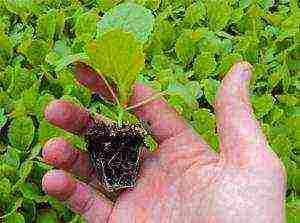 Caring for Chinese cabbage, as well as for any vegetable crop, consists of watering, weeding and feeding the plants.
Caring for Chinese cabbage, as well as for any vegetable crop, consists of watering, weeding and feeding the plants.
- To obtain good yields, an optimal balance between air temperature and humidity is extremely important, this statement is especially true during the formation of a head of cabbage and a rosette.
Air temperature:
- during the day from 15 to 19 ° C;
- at night not lower than 8 ° C.
Air humidity:
- on a cloudy day 70%;
- sunny day 80%;
- at night about 80%.
Soil moisture 65%.
If these requirements are not met, the leaves are often affected by various diseases, such as gray, white and black rot, as a result of which the plant does not develop normally and the formation of a head of cabbage does not occur.
Important! Despite the fact that the culture needs well-moistened soil, it does not tolerate stagnant water.
- Nutrition - Chinese cabbage prefers fertile soil, which is rich in nitrogen and calcium. But even if the land of the garden is poor in organic matter and trace elements, it does not matter. The plant responds well to various fertilizing of both natural origin (mullein) and to feeding with complex fertilizers.
- Autumn - for each m² you need to add 4.5 kg of manure, 1.5 dessert spoons of double superphosphate and 2.5 dessert. tablespoons of potassium sulfate. In the absence of the latter component, it can be replaced with ordinary wood ash at the rate of 1 liter can per 1 m² of soil;
- before planting - a solution prepared from poultry droppings (water 10 liters and ½ kg of droppings) or from eggshells (30 grams of crushed shells to insist for 2 days in 5 liters of water) is introduced. If, for some reason, fertilizers were not added to the soil in the fall, then before planting, during spring digging, you need to add potassium sulfate, superphosphate and ammonium nitrate, each component is taken in the amount of 1 tbsp. l. for every m².
Important! Peking cabbage has a high ability to accumulate nitrates; therefore, it is not recommended to apply fertilizers during the growing season. All fertilization must be applied before the plant is planted on the site.
- Watering - in dry weather, it is necessary to water every day, it is better to do this by sprinkling, in this case the plants receive the required amount of moisture and at the same time the soil does not become overmoistened.
Peking cabbage pests and methods of dealing with them
In fact, there are not so many pests that infect Chinese cabbage:
- cruciferous flea;
- slugs;
- cabbage butterfly;
- cruciferous bug.


Given that the culture has the ability to accumulate harmful substances in itself, it is not chemical preparations that are most acceptable for pest control, but folk methods that, with regular use, give excellent results.
- Planting a crop between rows of tomato, onion or garlic significantly reduces the activity of the cruciferous flea. As a stronger remedy, it is recommended to spray the plants and soil between the rows with a special solution. To prepare it, you need to take green potato and tomato tops (200 g of each component), and 2 large heads of garlic. Grind all the ingredients and let them infuse for about a day. The Peking cabbage photo, which is located below, was planted exactly according to this principle - between two beds of onions.
- Thorough and systematic removal of weeds also prevents damage to plants by the cruciferous flea beaver.
- After the appearance of cabbage butterflies in the garden, it is necessary to examine the lower surface of the leaves as often as possible, if clutches are found, the eggs of the pest are destroyed, this method, although laborious, gives good results, since it significantly reduces the likelihood of the appearance of caterpillars.
Tips for growing Chinese cabbage - video
Cabbage is a vegetable from which you can make a lot of excellent salads. However, it is not only famous for its amazing taste, but also provides the body with useful substances and vitamins. Today there are a huge number of different varieties of vegetables, they are all simply saturated with vitamins and differ from each other in appearance. One of the most beneficial for the body is Peking cabbage, which in recent years has become more and more popular among culinary experts around the world.
What is Chinese cabbage
Peking cabbage is a biennial plant that is grown as annuals. Depending on the variety, it has light yellow or bright green leaves. This plant is a loose head of cabbage with juicy tender leaves that have a white vein. The edges of the leaves are beautifully wavy or jagged.
The peculiarity of the variety is that it does not have a stump. The head of cabbage of the plant is thrown into soup or pickled, and the leaves are used mainly for making salads. Asia is famous for pickled Peking cabbage. They call this dish kimchi and many believe that it prolongs life.
 How Chinese cabbage grows
How Chinese cabbage grows
Feature and history of origin of the vegetable
Peking cabbage appeared in China several thousand years ago, then it came to Korea and Japan, and eventually spread to Asian countries. After a while, this vegetable became popular in Europe, as well as in our country.
Beneficial features
Why is Beijing becoming more and more popular? This plant is a source of nutrients and vitamins. The main advantage of the variety is that even in winter it does not lose its vitamins and benefits the body.
The most important useful substances that are included in its composition include:
- protein;
- mineral salts;
- vitamins C, A, K, PP, as well as a group of B vitamins;
- amino acids;
- organic acids.
In addition, "Peking" also has medicinal properties. It helps:
- with cardiovascular diseases;
- stomach ulcer;
- strengthens the immune system;
- prolongs the life of a person.
Very interesting is the fact that this vegetable contains lysine, which helps cleanse the blood and destroys foreign proteins.
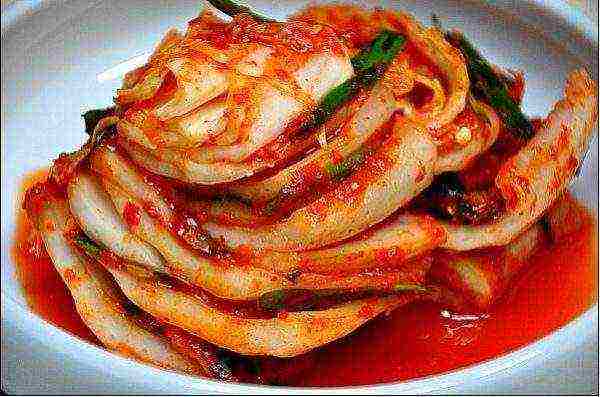 Chinese cabbage kimchi
Chinese cabbage kimchi
The right way to plant Chinese cabbage at home
What gardener does not dream to please himself and others with new achievements and grow Chinese cabbage at home. To grow this plant from seeds, you can plant them immediately in open ground, or you can grow seedlings first. Planting Chinese cabbage at home both in Belarus and the Moscow region and in the Urals and Siberia follows the same scheme.
The only difference is when to start sowing seeds and when the vegetable begins to bloom. If you decide to use the first method, then you should punch holes in the garden at a distance of 30 cm from each other and pour humus into them. Seeds are sown to a depth of no more than 2 cm. They are sprinkled with ash on top and covered with a film. After a week, you will be able to see the first shoots.
Seed planting scheme
What to do and how to plant seeds in the country or in the garden to get a good harvest? It is necessary to choose the right sowing time. The term for planting cabbage in the garden:
- in spring from and to April 20;
- in summer from July 19 to August 9.
 Chinese cabbage seeds
Chinese cabbage seeds
Growing and caring for seedlings
If you want to get an early harvest, then "Peking" for seedlings should be sown at the end of March. And if you dream of enjoying the harvest in winter, then the seedlings should be planted in the second half of June.
Loose soil is suitable for this plant, therefore for sowing it is best to use a mixture of humus (1 kg) with coconut substrate (2 kg).
The seeds are immersed in the ground no more than 1 cm and placed in a dark and warm room. When the first shoots appear after 3 days, they should be transferred to a lighted place.
You need to take care of Chinese cabbage no more than ordinary white cabbage or cauliflower.
It is necessary to water the seedlings when the upper earthen lump dries out. However, 4 days before transplanting seedlings, watering is stopped.
In general, the sprouts will be ready for planting in a month, when they have 4 leaves each.
 Seedling cabbage
Seedling cabbage
Why is it not necessary to make a dive?
This plant does not like picking and takes root in a new place for a long time. Transplanting or planting seedlings while preserving the roots will not work. It will take a long time to settle in a new place. Therefore, it is not recommended to dive it - it is better to initially sow it in separate containers or peat tablets.
When to plant outdoors
Before planting seedlings in open ground, it must be hardened. To do this, young sprouts are taken out into fresh air, first for a couple of hours, then the time spent outdoors is gradually increased. When they are able to spend a day on the street, then the seedlings will be ready for planting in a permanent place.
As for the soil for this vegetable, it should be well-drained and loose. Loamy soil is an excellent option. In addition, a plant of this variety should not be planted in the place where tomatoes and beets used to grow.
The soil for planting such a wonderful variety begins to be prepared in the fall. To do this, dig up the soil and add lime to it. When the soil is dug up in the spring, then humus is added to it.
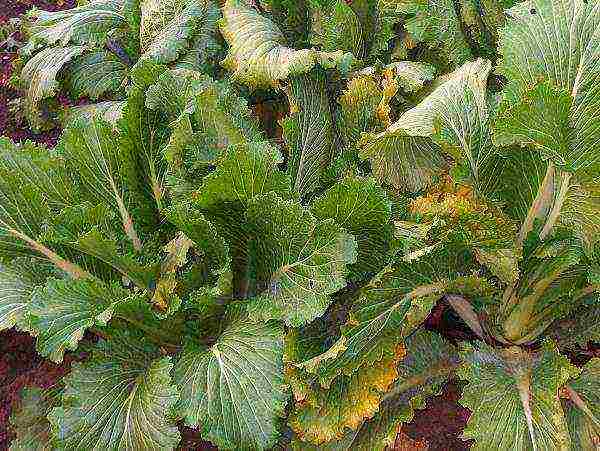 Growing Chinese cabbage
Growing Chinese cabbage
How to grow and care for a Peking in a greenhouse
"Peking" feels great in the greenhouse. However, for this it is necessary to strictly adhere to 2 rules:
- Observe the temperature regime from 15 to 20 degrees - therefore, an unheated greenhouse will not work;
- Air humidity should be within 70-80%.
If these norms are not observed, then a peduncle may form, and the plant will also be subject to various diseases.
The advantage of growing Chinese cabbage in a greenhouse is that you can independently adjust the length of daylight hours and maintain the optimal temperature. A greenhouse will also help keep your crops free of frost. And if you have it heated, then you can grow this plant even in winter.
 Chinese cabbage in the greenhouse
Chinese cabbage in the greenhouse
Care rules
This plant is very fond of moisture, coolness and light.Young sprouts are especially sensitive to temperature changes and frost. Therefore, in order to protect them and allow them to bloom, it is necessary to cover them with a non-woven fabric.
In addition, the canvas will also protect the vegetable from direct sunlight on particularly hot days. It also helps to remove excess moisture and hide sprouts from the cruciferous flea that loves to profit from it. Mulching the soil can also be helpful to retain moisture and prevent weeds.
To get an excellent harvest, the vegetable must be watered once a week with warm water.
Top dressing also has a fruitful effect on it. The first feeding is carried out 14 days after planting in open ground.
Infusions from chicken manure, grass or mullein are especially useful. A liter of such fertilizer is poured under each plant. If cabbage was planted in spring, then feeding must be done 3 times, and if in summer, then 2 times.
If you want to get a good ovary, then it is worth adding 2 g of boric acid to a liter of hot water and 9 liters of cold water and treating it with this solution.
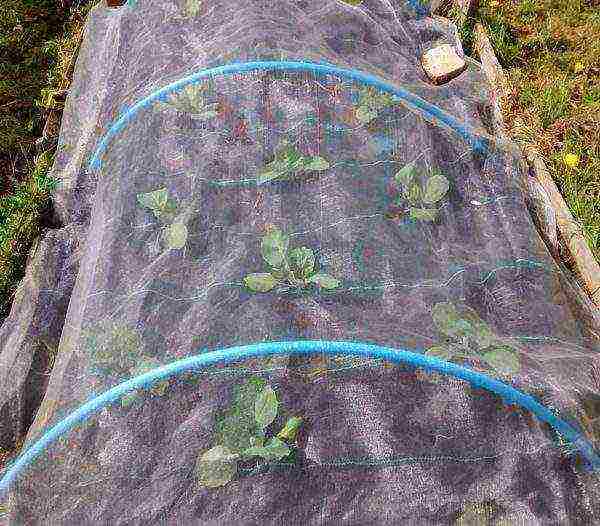 Covering planted seedlings
Covering planted seedlings
Harvesting and storage
In order for the vegetable to lie in the cellar as long as possible, it is better to give preference to the varieties that are harvested in September. And also the more leaves remain with the head of cabbage, the longer the plant will be stored. In addition, it will lie longer if it is placed in a room with high air humidity. Moreover, each head of cabbage is well wrapped in plastic wrap. You should also inspect each head of cabbage every 14 days, remove dried or rotten leaves.
Never store Peking next to apples. They secrete a substance that causes the leaves of the plant to wilt.
You can also store cabbage in the refrigerator or on the balcony. The main thing is that condensation does not form on it, and the temperature does not drop less than 0 degrees.
In general, when storing cabbage on a balcony or refrigerator, you need to follow the same rules as when storing in a cellar.
You should also know that the vegetable will lie in such conditions from 1 to 4 months. If you want it to last longer, then you can use the following storage methods:
- leaven;
- drying;
- freezing.
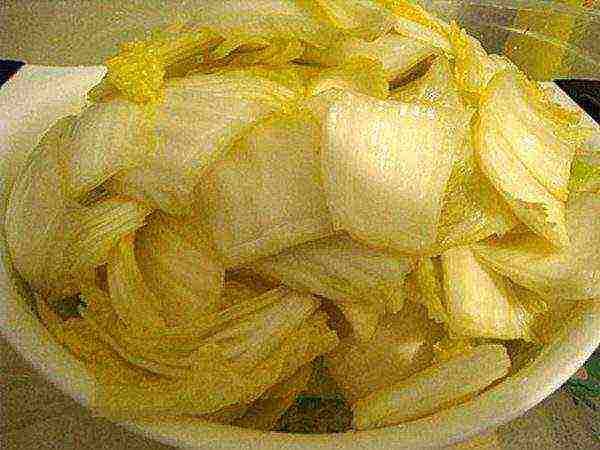 Sauerkraut
Sauerkraut
The first way is leaven. It is one of the simplest storage methods. The sourdough recipe is very simple: you need to pour 10 kg of shredded cabbage with 600 ml of water and add 100 mg of vinegar, 2 tsp each. salt and sugar, as well as 2 cloves of garlic squeezed through a press. Further, under the press, all this should stand in a room with room temperature for about a day, and then 14 days in the cold.
To dry the "Peking", it is cut into strips and placed in an oven heated to 100 degrees and the door is slightly opened. It will be ready in 4 hours, after which the dried vegetable is placed in cotton bags.
For freezing, chopped cabbage is thrown into salted boiling water for 3 minutes. After that, the vegetable is dried and frozen.
As you can see, Chinese cabbage is a wonderful plant that will look like decoration on any table. Do not be afraid to take up the cultivation of Peking, because it is not picky about care and is very useful. Therefore, each gardener should allocate a place in his summer cottage of Peking cabbage.
Peking cabbage is an extremely tasty and healthy product, which is why it is increasingly included in the diet. And thanks to its unpretentiousness, this vegetable is successfully grown in an ordinary garden, and both experienced gardeners and beginners. Let's figure out what kind of culture Peking cabbage is, and how laborious it is to grow and care for it.
Peking cabbage: growing and care, photos of seedlings and adult plants in the open field
The crop is stored for a long time without losing its properties, which means that stocking up on Peking cabbage for the winter is not a problem.In addition, as many as two harvests are obtained per season, and for those who did not have time to plant cabbage in the spring, you can have time to do it in the summer.
Of course, like any culture, Peking cabbage has its own "troubles" and whims, which, with due attention, are easy enough to cope with. You just need to know and adhere to certain agricultural techniques.
Peking cabbage can be grown in both seedling and non-seedling methods. Naturally, the first method is preferable, but it is also possible to grow a full-fledged cabbage with the second.
Growing healthy and robust Chinese cabbage seedlings
Growing Peking cabbage using seedlings allows you to get a ready-to-eat vegetable earlier, since the ripening period for seedlings is reduced, and it grows much faster. There are two times for sowing seeds for seedlings - either the end of March or the end of June. Since "pekingka" is disgusting about picking, after which it does not always root successfully, it is best to place the seeds immediately in separate containers, for example, peat pots.
When planting, special attention is paid to the soil for seedlings - this vegetable loves a loose consistency. You can use one of the options:
- Humus + coconut substrate, in a ratio of 1: 2, respectively.
- Peat + sod land, in a ratio of 1: 1.
The selected version of the mixture is filled in pots. Seeds are sunk into the soil by about 1 cm, no more. After a few days, provided that the containers with seedlings are kept in a dark place next to the battery, sprouts can be seen. After that, they are taken out into the light - they are placed on the windowsill.
Peking cabbage seedlings should not be "drained", watering is carried out only after the soil from above begins to weather. After a month of this regime, the sprout should have at least 4 leaves, and then it is ready for planting in open soils. It should be noted that before planting in the beds, watering the seedlings is not carried out for several days.
Planting Chinese cabbage by seeds directly in open ground
The place for planting this vegetable using the seedless method should be chosen correctly - it should have good lighting, in no case be in the shade - sheds, fences and other crops. In addition, the ideal option would be to plant in the part of the plot where cucumbers, garlic onions, and carrots were grown last year.
Vegetable planting scheme - a square of 30 × 30. In each hole dug, add ½ liter of humus, sprinkle with wood ash, and then spill well.
Peking cabbage seeds are sunk into the soil for a few centimeters, sprinkled with the same ash on top. After that, Beijing cabbage needs to arrange mini-greenhouses. It can be agrofibre, film, plastic bottles, any other suitable covering material. The first shoots can be expected in a week.
Observing the planting time of Peking cabbage: getting rid of the "flowering"
It often happens that Chinese cabbage, instead of forming a full-fledged head of cabbage, begins to grow upward, throws out a peduncle. To avoid this, it is necessary to strictly observe the timing of planting it in open ground.
The fact is that the flowering of cabbage begins if the seedlings grow with a long daylight hours, therefore, it is necessary to plant the sprouts when the daylight hours are still short or already waning.
Therefore, the timing of planting cabbage is as follows:
- Second half of April;
- End of July - beginning of August.
With this observance, there should be no shooting. In addition, to avoid it, they choose specially bred varieties that are more resistant to empty flowering, Dutch hybrids are especially distinguished among them.
As for ripening, although Peking cabbage is considered an early-ripening vegetable, nevertheless, according to the timing, varieties are divided into early, middle and late. The first ones ripen after 1.5 months, the second ones need up to 2 months, and the ripening periods of late varieties reach 80 days.
Features of growing Chinese cabbage
After rooting cabbage in the open field, it is necessary to observe a comfortable regime for it, which consists in ensuring optimal humidity, temperature and light flux.
As for the temperature regime, in order to obtain a good harvest, it must vary from 15 to 20 degrees. Both lowering and increasing it will reduce the likelihood of getting a healthy vegetable. Peking cabbage is moisture-loving, but an excess of moisture can cause it to rot.
To provide the "Beijing" with the proper atmosphere, a non-woven fabric is often used to cover the plantings. It provides several conditions at once:
- Temperature constancy. Protects against drops, and also from possible frosts, which bring death to plantings. Also protects from the scorching sun, keeping the space cooler inside.
- Constancy of moisture. Protects from both excess (in the rainy season) and lack of moisture (accumulates and stores)
- Pest protection. The fiercest enemy of Peking cabbage is the cruciferous flea. Finding cabbage under the canvas is much more difficult for a pest.
To retain moisture and partially get rid of weeds, sprouts of Peking cabbage are treated with mulch, it is advisable to do this 2 weeks after planting.
During the entire period of ripening, "Peking" is fed:
- 10-14 days after planting seedlings in open ground, or after seedlings have appeared in the open ground, pour a liter of mullein (diluted 1/10), or infusion of chicken manure (diluted 1/20) or herbal solution (diluted 1/9). The introduction of such dressings should be carried out two to three times during the cultivation process.
- Top dressing with Borogum-M solution: 2 tablespoons of the drug are thoroughly mixed in 1 liter of water, and sprayed (foliar dressing) 2-3 times during the growing season.
Enemies of Chinese cabbage and how to defeat them
There are two especially zealous pests in Peking cabbage - a cruciferous flea and slugs. Everyone knows that the best treatment is prevention, so you should definitely:
- observe the timing of planting the vegetable (this is the time when the cruciferous flea has not yet appeared, or has already disappeared);
- cover seedlings with a non-woven cloth, protecting them from pests;
- observe crop rotation, i.e. do not plant where mustard or common cabbage (and other cruciferous species) grew before. Indeed, most often the larvae of the pest are in the soil in winter, be sure to get out in the spring.
The "war" with the cruciferous flea includes:
- Treatment of plantings with ash and tobacco dust / Tabazol. Flea does not like such scents.
- Mixed landings. If you plant Chinese cabbage between tomatoes, cucumbers, potatoes, then the flea may be deceived and not find it.
- Spraying with preparations of the Fitoverm type.
- Chemistry (for the most courageous) - Aktara, Iskra, Aktellik. They are used in desperate situations, and no later than a week before the expected harvest of the vegetable.
Slugs are another scourge of Peking. If the rainy season has come, then you may not have time to blink an eye as slugs devour the plantings of Peking cabbage cleanly.
To kill slugs, you can try:
- Lay boards and burdock leaves between the cabbage rows, under which pests like to gather. After a while, the boards and leaves are removed, and the slugs are destroyed by hand.
- Sprinkle the cabbage with the pre-cooked mixture. Take ½ liter of wood ash, in which 2 tablespoons of salt are mixed, the same amount of crushed red pepper, and 1 tablespoon of mustard is added (in dry form).
- Watering cabbage with water in which brilliant green is diluted (1 bottle per 10 liters).
What is the harvest time for Beijing cabbage for storage?
Peking cabbage of early, spring planting is grown only for current consumption. But Peking cabbage of the second harvest (they are also called repeated crops) is excellently stored, it can withstand cold temperatures of -4 degrees without damage to itself.That is why you should not rush to collect summer plantings, you can safely leave cabbage until the second half of October. It is better to look at its readiness by touch - according to the density of the head of cabbage. It should be very dense, not loose.
In order for the cabbage to be successfully stored until the new year (and even after), each head of cabbage is wrapped with cling film before being sent for storage, or you can use a newspaper and a plastic bag, only in the latter version you will have to periodically check the newspaper so that the vegetable does not rot. Storage temperature +5 degrees.
Subject to all the rules of planting, growing, care and storage conditions of Peking cabbage, a magnificent harvest is obtained, pleasing its owners almost all winter.
Source
For the first time, Peking cabbage was introduced into the culture in China, it was a very, very long time ago: according to some data, more than 4000 years ago, according to others, more accurate, more than 5500 years ago. This vegetable is very widely used in cooking, it lends itself well to frying, stewing, cabbage is added to a variety of soups, and consumed raw. From China, Peking cabbage came to Korea, Japan, the countries of Southeast Asia. It is interesting that in Europe they really learned "well" about Peking cabbage only 60 years ago and is now grown in almost every vegetable garden, and of course, on an industrial scale, especially in America. Our article is about the features of growing Chinese cabbage.
Planting Chinese cabbage
Content:
- Description of Chinese cabbage
- The use of Chinese cabbage in cooking
- Features of growing Chinese cabbage
- What is the best way to grow Chinese cabbage - by seeds or seedlings?
- How to care for Chinese cabbage?
- Peking cabbage pests and control
- Peking cabbage harvesting and storage
- Peking cabbage varieties
Description of Chinese cabbage
Peking cabbage is a completely unpretentious vegetable crop; during the warm period, it may well endow a vegetable grower with not one, but a couple of crops. Another advantage of Chinese cabbage is that it is not so difficult to grow it, and even novice gardeners can usually cope with this.
Caring for Peking cabbage is simple, it is not a capricious culture, it grows very actively, it is well preserved, it has useful properties and good taste.
Peking cabbage looks like a cross between white cabbage and lettuce, but it still belongs to the cabbage family. The head of this cabbage is not elastic, like that of a white cabbage, it is elongated and has quite a lot of oblong and wrinkled light green leaf blades.
The use of Chinese cabbage in cooking
Due to its very pleasant taste, Peking cabbage is often used as a salad plant. The leaves are not only eaten fresh, but also often serve as a simple decoration for dishes, as if emphasizing the taste of cooked food. Peking cabbage contains a large amount of fiber useful for the stomach and intestines, a whole range of minerals and vitamins.
There are a lot of dishes made from Peking cabbage or with its use; whole cookbooks have been published, where Peking cabbage is the main ingredient in each recipe.
Features of growing Chinese cabbage
Peking cabbage, in addition to the advantages described above, has many other things: it is very early ripening, it takes from 45 (early varieties), 60 (mid-season varieties), to 80 (late varieties) days to harvest Peking cabbage.
Peking cabbage also has its own problems: in addition to the enemies, which we will definitely talk about below, it is a tendency to form arrows with flowers, which then give seeds. Even when sowing seeds (not seedlings), cabbage can throw out the arrow and bloom; naturally, there can be no question of any exquisite taste or presentation in this case.
How to Avoid Peking Cabbage Shooting?
In order for Chinese cabbage to forget about flowering, you should plant seedlings or sow the seeds of this plant at a certain, most appropriate time. Usually Peking cabbage "leaves" in the arrow when the daylight hours are very long; therefore, it is necessary to sow seeds and plant seedlings when the daylight hours are short - this is the very middle of spring, that is, April or mid-summer, closer to the beginning of August.
It seems that the daylight hours during this period are quite long, but believe me, these are optimal periods for cabbage, and it will not throw out arrows.
What is the best way to grow Chinese cabbage - by seeds or seedlings?
By the way, we mentioned that Peking cabbage can be grown in two ways: by direct sowing of seeds into the ground and through seedlings, that is, by first growing it indoors, and then planting it in the ground. We can immediately say that growing Peking cabbage by sowing seeds in the ground is also a good way, but it is advisable to use it for residents of the southern regions, while residents of central and cooler regions need to take care of growing seedlings first. But we will certainly tell in this material about both methods of growing Chinese cabbage.
Seedling of Chinese cabbage
Growing Chinese cabbage through seedlings
Let's start by growing through seedlings. What is important and needs to be remembered here? Firstly, seeds for seedling can be sown twice a year, that is, the first time around mid-March or a couple of days later and the second time around mid-June, but with a shift towards July also for a couple of days.
The second harvest of Peking cabbage (summer) usually keeps better than the first. Remember: the culture is capricious in terms of picking and it is sick for a long time on the planted area, it takes root slowly, so we would advise you to sow the seeds directly into peat-humus pots, from which you will not need to transplant. The pots decompose in the soil when planted in the ground, thus the root system is not injured, and the seedlings take root faster.
It is better to fill the pots with a mixture of completely rotted organic matter, sod land, river sand and garden soil in equal proportions with the addition of 500 g of wood ash per 10 kg of substrate. When sowing Chinese cabbage, lightly water the soil and deepen the seed a centimeter, no more. Next, place the seed pots in a room with room temperature (+ 20 ... + 22 ° С).
If you want the seeds of Peking cabbage to sprout faster, then before sowing, soak them for a day in gauze soaked in any safe growth regulator - Epin, Heteroauxin and the like, and then place the pots with seeds at the bottom of the box and cover the food box film.
Try not to change the temperature in the room, spray the surface of the soil in pots from a spray bottle, preventing it from drying out. If you do everything correctly, then in four days, and sometimes even earlier, sprouts of Peking cabbage will appear. Immediately after their appearance, the film must be removed, and the containers must be placed on the southern windowsill.
Caring for seedlings of Peking cabbage consists in watering (taking into account soil moisture) and providing plants with a daylight hours equal to 12-13 hours, no more. LED lamps are well suited for additional lighting.
After the appearance of four or five well-developed leaves, which is usually observed in Peking cabbage after 25-30 days, the seedlings (after one week of hardening) can be planted on the site.
Hardening is an important stage, it consists in the gradual adaptation of plants to more severe conditions. Great if you have a closed balcony or veranda. When the plants form the appropriate number of leaves, the seedlings can be taken out there for a couple of hours, the next day the time the seedlings stay on the balcony or terrace can be doubled, and so this time can be brought to a day.
After hardening, it is permissible to plant Peking cabbage on the beds, for this you need to pick up a loose bed, always well lit, without stagnation of irrigation water. When planting, be sure to take into account those crops that grew on this bed earlier, for example, Peking cabbage grows remarkably after onions, garlic, carrots and potatoes, but after crucifers it is bad.
Growing Chinese cabbage without seedlings
To do this, you first need to prepare the soil, however, as when planting seedlings in open ground, dig up shovels with a full bayonet, break lumps, loosen, after making sure that worthy predecessors occupied the garden bed, or the soil was fallow.
After the beds are placed in a perfectly lit place, devoid of any, even a small shadow, it is necessary to sow the seeds of Peking cabbage in holes or grooves, deepening each centimeter by two, no more. After sowing, it is advisable to water the soil either with a spray bottle or from a watering can, but with a nozzle that has very small holes.
Important! Remember to place the seeds and plant the Chinese cabbage seedlings at the optimal distance, usually 35 cm between plants and 40 cm between rows.
If you sow Peking cabbage in dry weather, then after watering the soil surface, in order to preserve moisture as much as possible, you need to lightly sprinkle it, literally dusting it with wood ash, oven ash or soot. If the weather is cool and there may even be frosts, then the crops should be covered with a transparent film. When sowing seeds in the soil of open ground, the seedlings will have to wait twice as long as when sowing in peat-humus cups.
Peking cabbage seedlings planted in the garden
So, we found out - Peking cabbage prefers a relatively short day, but loves to grow in a well-lit place, loves the abundance of water in the soil and tolerates well, one might even say - loves, coolness. If it is cold outside for summer - from +16 to + 19 ° С, then for Peking cabbage this is just right. The high temperature, when the "burdocks" grow, and the low temperature, when the cabbage does not grow corny, can drastically reduce yields.
Considering all this, we advise you to immediately stock up on non-woven covering material and hard wire arcs and, if it is cold, then cover the plants. Such an impromptu greenhouse can save cabbage from sudden temperature changes, slightly raise the air temperature or lower it a little - accordingly, the shelter must be installed at night or for the day. In summer periods, characterized by excess rainfall, such a shelter can save Peking cabbage from rot, because, as we have already said, it loves plenty of moisture, but not its excess.
When caring for Peking cabbage, loosening the soil, without waiting for the formation of a soil crust, watch out for the timely removal of weeds. It is better to remove them by hand after rain or watering the soil, then they are pulled out with the maximum number of roots.
After removing the weeds, the soil can be mulched; a centimeter layer of wood ash, stove ash or stove soot is suitable for this, but ordinary dry soil can also be used. You can start loosening the soil and mulching about 25-30 days after germination or 15-20 days after planting seedlings.
Important! When watering Chinese cabbage, try to use rainwater.
Her Peking cabbage simply adores: put a barrel of 300 liters under the drain and paint it black, then the water will warm up in a day, that is, the benefits when watering will turn out to be double. You can water it either every other day, but little by little, about 2-3 liters per square meter, or you can water it once a week, but pouring a bucket of water per square meter.
Top dressing of Beijing cabbage
How many times it is necessary to feed Peking cabbage depends directly on the time of planting seedlings or sowing seeds in open ground.If the seedlings of Peking cabbage (or sowing seeds) were planted (carried out) in the spring, then it is better to carry out three dressings; and if in the summer, then two will be enough.
Fertilizers are best applied when dissolved in water. As fertilizers, you can use nitroammophoska (a tablespoon per bucket of water, the rate is 2-3 liters per square meter), or a variety of natural infusions.
For example, you can fertilize plants with a mullein, diluting it ten times, after which, after insisting for a couple of days, start watering with this solution - two liters will be enough per square meter. Infusion of bird droppings is suitable, only it needs to be diluted 20 times and let it brew for three days, the consumption rate is the same. Peking cabbage responds well to an infusion of weeds, especially nettle - you need to mow about a kilogram of fresh, young nettle and fill it with a bucket of water, let it brew for a week, dilute it twice and you can water it, spending five liters of such infusion per square meter.
If you want Chinese cabbage to form a dense ovary, then use an infusion of boric acid. To prepare it, it is necessary to literally dissolve a gram and a half of boric acid in a bucket of water and let it brew for a day, then fill the spray bottle and process the plants directly on the foliage in the evening.
Chinese cabbage in the garden
Now let's talk about the worst pests of Chinese cabbage; in our opinion, it is a cruciferous flea and slugs. Since Chinese cabbage is often eaten fresh, and it ripens rather quickly, we would not recommend using pesticides, but we recommend using folk remedies.
First of all, these are:
- observance of crop rotation (no cruciferous plants should grow in the garden to Peking cabbage);
- adherence to the landing time, which we wrote about;
- the use of shelters that will reliably protect from pests;
- the use of ash (wood or stove) or soot (with any of these compositions, as soon as seedlings are formed or immediately after planting seedlings, it is permissible to slightly powder the soil).
Before winter, always dig up the soil on a full bayonet of a shovel without breaking clods, and although the larvae of the pests are very tenacious, most of them will die from frost.
Sometimes even joint planting helps from pests, for example, they often do not touch tender cabbage leaves if cucumbers, tomatoes or onions with garlic grow nearby.
In the most extreme case, at least 25 days before the harvest, it is permissible to use insecticides, only permitted and strictly following the instructions on the package, but we advise you to try first treating the cabbage with biological preparations such as "Bitoxibacillin", sometimes it helps well.
Now about slugs, they also cause considerable harm to Chinese cabbage, literally devouring it. Slugs "work" in the dark and sometimes gardeners do not even understand who could have done this with cabbage.
Slugs can be lime in a variety of ways. One of the simplest is placing planks, pieces of slate, plastic, roofing material on the surface of the soil where Peking cabbage grows. As a rule, after a night feast, slugs seek refuge for themselves, and such elements on the site seem to them to be a very reliable home. In the morning, you can remove everything you laid out yesterday and collect the slugs that have accumulated under the shelters.
Another option is a wild mixture of wood ash - 250-300 g and hot pepper - about a tablespoon. This composition can be sprinkled on the soil around the Chinese cabbage, before rain or watering, it helps, but then this procedure has to be repeated.
Gardeners also note the effectiveness of the usual "brilliant green", just one bubble is enough for a bucket of water and this amount - for about five square meters of soil.
Peking cabbage harvesting and storage
Peking cabbage is a fairly cold-resistant culture, frosts down to -2 ... -3 ° C are not at all afraid of it, it continues to grow and develop as if nothing had happened.Often, gardeners carry out the second harvest in mid-October in the center of Russia and in mid-November in its southern regions.
When sowing or planting Peking cabbage in the spring, you need to harvest the cabbage, focusing on the state of the head: as soon as it becomes dense, and naturally, a period of time typical for this variety has passed, then the cabbage can be harvested by cutting.
Important! We would like to remind once again that it will be Peking cabbage that will be stored for the summer sowing or planting period, spring cabbage should be eaten fresh or put into processing quickly.
Peking cabbage of summer sowing or planting is well stored at a humidity of 80-85% and a temperature of + 4 ... + 6 ° С. Sometimes it is simply wrapped in plastic wrap and placed in the refrigerator, so it can also be stored for a long time.
Peking cabbage varieties
By the way, since we have already mentioned the varieties, let us very briefly name the novelties of Peking cabbage, the most famous seed-producing firms, and at the same time guide you, dear readers, in terms of its ripening.
So, early varieties of Chinese cabbage, This:
- "Medalist" (agrofirm "Poisk", head weight up to 1.6 kg);
- "Shanghai" (agrofirm "Aelita", head weight up to 1.3 kg);
- "Sentyabrina" (agricultural company "SeDeK", head weight up to 1.1 kg);
- "Miss China" (agricultural company "SeDeK", head weight up to 1.0 kg);
- "Spring Beauty" (agricultural company "SeDeK", head weight up to 2.0 kg);
- "Autumn nephrite" (agricultural company "SeDeK", head weight up to 2.9 kg);
- "Naina" (agrofirm "SeDeK", head weight up to 3.0 kg);
- "Lyubasha" (agrofirm "Poisk", head weight up to 2.1 kg).
Peking cabbage varieties, medium in terms of ripening:
- "Harbin" (agricultural company "Gavrish", head weight up to 1.8 kg);
- "Aikido" (agricultural firm "Gavrish", head weight up to 2.0 kg);
- "Orange heart" (agricultural company "SeDeK", head weight up to 1.5 kg);
- "Granata" (agricultural company "SeDeK", head weight up to 2.3 kg);
- "Autumn beauty" (agricultural company "SeDeK", head weight up to 2.4 kg).
AND late variety of Peking cabbage:
- "Spring nephrite" (agricultural company "SeDeK", head weight up to 3.0 kg).
Do you grow Chinese cabbage? What sort of? What interesting dishes do you like to cook with it? Share your experience in the comments on the article!

